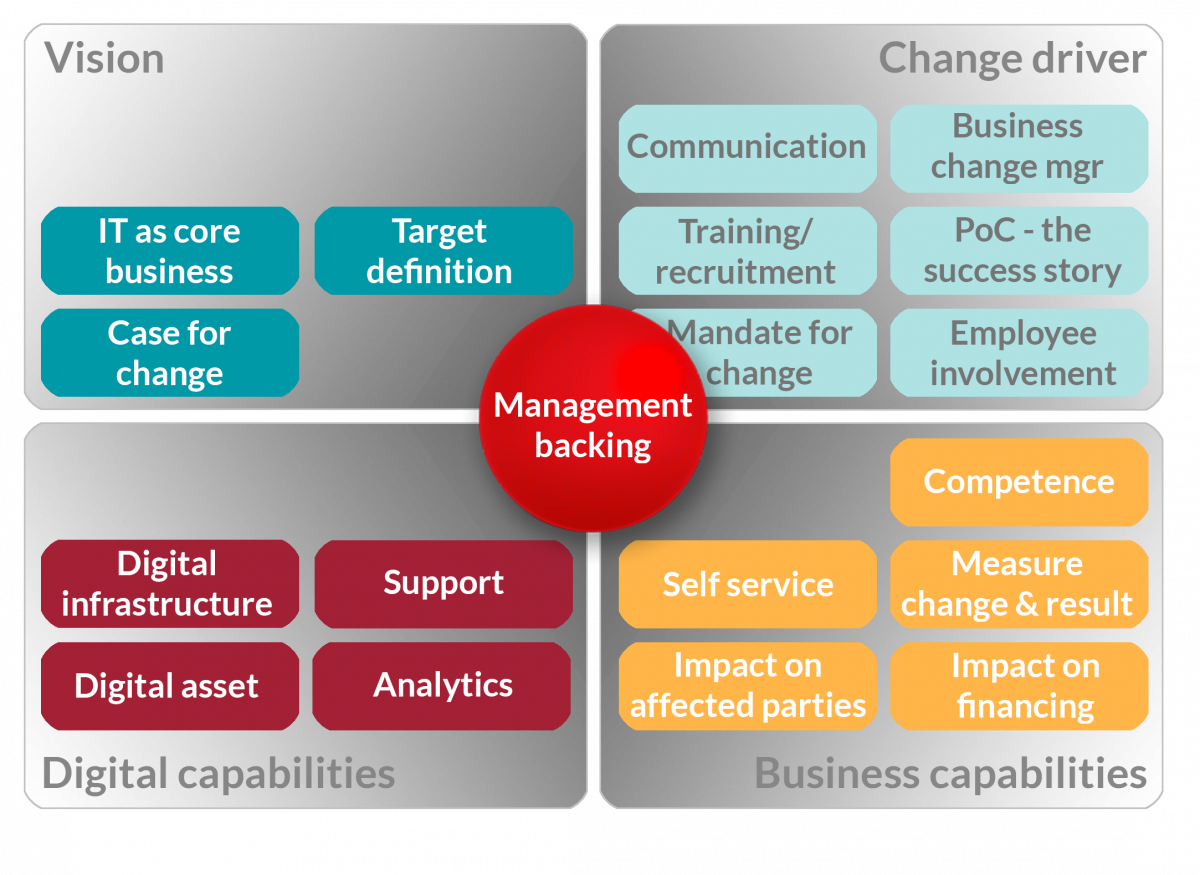Digital Ready Model - a model that explores the foundations to achieve true digital innovation and the capabilities that your organisation need to have in place to achieve the transformation you are aiming for.
In this blog post we will cover the digital capabilities quadrant of the Digital Ready Model.
Apart from a vision and change driver capacity paired with management support to be successful, you will of course also require digital capabilities to reach your objectives.
It might very well be that your organisation has a lot of various IT systems or solutions that have been purchased or developed over the years. In many cases these solutions have been around for quite some time and were often not built to cater for the demands of your ongoing digital innovation program.
Maybe the existing IT solutions were implemented to support processes that you want to completely revamp as part of your new program. Many times, existing solutions are built using old technology (it was probably modern by the time the solution was developed) and this makes it costly and hard to change them.
Maybe you also have problems with user adoption, since many of these systems were developed when client-server thinking and fat clients were still in the mood, which makes them hard to adopt to the whole web and adoptable UI thinking of today’s popular applications.

Digital infrastructure
To support your digital innovation initiative, you will require a modern digital infrastructure to support you. A modern digital infrastructure should be easy to modify, scale and integrate.
This way you have created the foundation to support new ways of thinking when it comes to interaction with customers or partners, process design, data access and analysis. Your digital infrastructure should be easily accessible and scalable. A popular way to do this is to make use of cloud or SaaS offerings.
These kinds of solutions are often easy to get started with and scales when usage increases. That makes them cost efficient, as you can try before you fully commit to the platform. From a strategic perspective it is important to consider the lock-in effects before you commit to any of these solutions.
Maybe an Open Source based solution is to prefer, rather than being locked in to a certain software, vendor or software that will drive costs over time.
An Open Source based approach and securing the rights to all development you pay for, secures that you can choose between different vendors over time and do not get tied to ”hard to understand” payment models or risk paying for software that you do not use. Another key capability is the ability to integrate between different software solutions.
To make it possible to choose the software that gives you the best support for a certain use case, it is important that data does not gets locked in or that you are not able to share information with your stakeholders.
This is where the capability of integration and APIs comes into play. A thought-through and well implemented strategy paired with the right tooling/platform gives you the ability to unlock information and make it available wherever necessary to support processes or do the correct analysis.
Digital assets
Already today you certainly have a lot of digital assets in your organisation. These can be information/data that are stored in various IT solutions and/or representations of your business in various ways. It is important for your digital innovation program to unlock these digital assets and make them available for other parts of the organisation to utilise for efficiency improvements or innovation.
The way to go about with this is to look for modern connectivity patterns and to use APIs to unlock information and assets.
With a smart use of APIs and a connectivity strategy that spans over the entire organisation you will unlock information and create the foundation that make it possible for your organisation to innovate for efficiency or invention of new processes to generate more business, improve service or increase cooperation with partners, whatever is on the agenda for your digital innovation initiative.
Analytics
To know whether your initiative is successful or not and if you are able to unlock your digital assets to the extent anticipated, you will need metrics to follow up on this. I would suggest simple KPIs to help you both monitor your own progress, and to make it visible to others. To secure a continued interest in what you are doing, visible progress is always an important factor.
The KPIs you chose are of course dependent on what you want to achieve, but if your key target is to unlock data and make digital assets available, the number of published APIs could be one KPI that indicates this.
Other indicators could be:
- number of APIs in the pipe,
- number of transactions being sent through the API Manager/portal
- number of registered subscribers
To enable easy access to data and digital assets is also about simplicity and conformity. To make it easy for subscribers to find and subscribe to the needed information, it needs to be simple to gain access and make use of data. The commonly used way to do this today is through well documented and easy to access APIs.
The APIs should be designed and documented in a stringent manner. If new APIs needs to be developed for every new system that connects, we would have achieved little, but if we can create APIs that are easy for every new system to connect with, we would suddenly have made it very easy to access our digital assets.
A popular analogy of us, is to compare these APIs with the power cords to access electric power. No matter how to apparel you want to connect to the power grid looks like, if the connector fits with the socket, power will flow, and magic happen.
Support
With new digital infrastructure available and the power of digital assets suddenly at hand, your organisation might need support to make use of these new capabilities. All opportunities at hand and no chance of utilising them, could make you frustrated.
This is why you also need to build a framework to support your organisation in their respective digital innovation initiatives. You might also need new functions or organisational units to support your fellow co-workers. Popular phenomena in this category is the introduction of a marketplace for all your APIs to support easy access to key digital assets.
With an API marketplace and self-service, potential subscribers would not have to seek information on APIs in various API Management solutions/GWs or contact system owners directly to gain access to data.
Through easily accessible APIs they can just subscribe to the information they require or send information directly through an API and be assured that it is taken care of. Another popular phenomena under this headline is to talk about ”Center for Enablement’s”. This is normally a small team/group of people that are skilled in how to develop and deploy APIs to unlock data.
They can be seen as a support team with the task of ensuring access to an API Manager/GW or Marketplace where APIs are to be published. They also set the standards for how these APIs are to be designed, developed, documented etc and educate the rest of the organisation on how to do this and gain access to APIs/information.
The ”Center for Enablement” may in short to be viewed upon as a support organisation to assist you to drive and make a reality of your digital innovation program.
We will launch our Digital Ready model in a viral way by releasing a series of blog posts to introduce each perspective in the model, this is the fourth article in this series. Below you will find a little ”sneak-peak” into the different pillars of the model.
Stay tuned in this forum for moreinformation on how to assure Digital Readiness....




